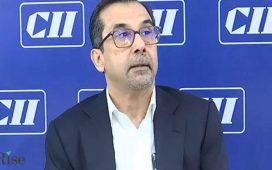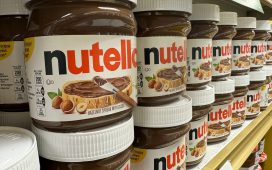Amazon parcels are prepared for delivery at Amazon’s Robotic Fulfillment Centre on December 19, 2023 in Sutton Coldfield, England.
Nathan Stirk | Getty Images News | Getty Images
Every year, the U.S. goes through enough cardboard boxes for shipping to pave a one-mile-wide road from New York City to Los Angeles three times, or build a mile-high cardboard wall around the entire continental U.S.
Among the primary targets to help reduce this mountain of packaging, the most notable may be the Amazon shipping box or envelope. In 2022, 11% of Amazon orders worldwide were sent in original manufacturer packaging. The company has yet to release its 2023 figure for the initiative designed to get rid of Amazon’s signature brown box, called the Ships in Product Packaging program.
It identifies products that might work, contacts vendors and then, to ensure that packages won’t be damaged during delivery, Amazon works with those companies to test products in a lab. Packages need to be able to survive drops off a conveyor belt, vibrations and shaking on the truck or the delivery person accidentally dropping the package while walking to the door.
“We qualify products ahead of time to make sure that they are going to deliver to customers without damage. Then we simulate the ecommerce fulfillment process as part of that testing process so as products are enrolled in the program, we make sure they meet that minimum standard to arrive safely,” said Kayla Fenton, Amazon senior manager of packaging innovation.
Testing varies depending on what the product is. Liquid items are more tricky than a stuffed animal. “Our tests are designed to react to the particular product type and its inherent fragility,” Fenton said. The test results are then fed into machine learning models which go through the Amazon catalog for more items that can be added to the program. For example, if a vendor sells a red tee-shirt, chances are the blue tee-shirt will perform just as well, Fenton said.
Products get tested five times, and each time something breaks, it helps the machine learning models evaluate what went wrong and how to fix it. Feedback from customers also gets fed into the system. If customers complain about damage and return more items because of it, Amazon can go back to using boxes.
Go North Group, a Fulfilled by Amazon aggregator that sells a wide range of home and garden goods, health, sports and pet products, was among those asked to join Amazon’s ships in packaging program. Johan Stellansson, Go North’s supply chain director, said the testing revealed that 80% of the company’s products can be shipped without additional packaging, including its MalsiPree portable water bottle for dogs.
In some cases, an extra piece of tape was enough to add some extra stability to the box so it could go through the shipping process undamaged, including some of the company’s pet stain and odor remover products, which come in bottles that are then packed in boxes. Bigger products that require a lot of padding didn’t make it into the program and Stellansson said it caused the company to reconsider whether it should continue selling the product on Amazon. “We wouldn’t develop a new product unless we can ship it in the manufacturer’s boxes,” he said.
Many efforts to reduce packaging remains works in progress, but a simple strategy Amazon is making more use of which reduces packaging use is boxes direct from companies including Clorox, McDonalds, and Starbucks with no additional Amazon cardboard.
Amazon
Amazon initially opened the program to vendors and has since opened it to sellers. Vendors are more like suppliers to Amazon while sellers operate more independently.
Fenton noted that as Amazon’s warehouse network has developed and gotten closer to customers in some areas, the delivery process is shorter, which allows the company to ship even more items with no packaging. Also, not all items make it into the program. Some never will. Personal items, such as adult diapers or sexual wellness products, will not be shipped without boxes or mailers for privacy reasons. Also, Fenton emphasized that customers can choose at checkout whether or not to ship in the manufacturer’s packaging.
Not all items can ship without a box or mailer. For that, Amazon has been working to reduce packaging, especially plastic — swapping out plastic bubble mailers with paper mailers and plastic bubbles with paper. It recently converted a fulfillment center outside of Cleveland, Ohio, from plastic to 100% curbside recyclable paper. The center uses a machine that scans items and then creates a box or envelope that is precisely the right size, reducing the amount of air and using less packaging, which adds weight.
Automation and machine learning play a role in minimizing packaging. “The more that we can automate, the more control we have over ‘right-sizing.’ We can really wrap or box to any size, dimension or product, provided that we can measure it properly with the cameras,” said Pat Lindner, vice president of mechatronics and sustainable packaging at Amazon. Ultimately, the move to reduce packaging has multiple benefits, saving money and reducing waste.
“We think this is good for the environment. We think this is good for the customers because it’s less material to have to deal with at home,” Lindner said.
Consumer habits remain tough to change
The move to reduce or eliminate extra packaging is just part of the solution. Another is reusable packaging. Amazon has experimented with reusables in the past — mainly through Amazon Fresh grocery deliveries — but discovered that too few customers returned the insulated totes.
Asking people to change their usual habits by returning packaging is an uphill battle. Even so, some companies are introducing reusable packaging, said Michael Newman, CEO of Returnity Innovations, which provides reusable boxes and bags for companies such as Rent the Runway and clothing brand Vuori.
Newman said that reusables work best when people don’t have to change habits. These circumstances include when people are already returning something or when they’re buying several sizes of the same item to try on at home. Reusable packaging can also work when goods are shipped to a retail store, and employees are responsible for returning the boxes.
“It doesn’t require behavior change from consumers,” he said.
Packaging is designed to withstand the average number of reuses, which could vary from five to 20 times, depending on the company. Newman said that for reusables to work from a carbon footprint perspective, customer return rates need to be 90% to 95%. Reusables typically use more resources, they’re thicker plastic, so if they are thrown out or not reused often enough, the environmental impact can be worse than using single-use plastic.
Matt Semmelhack, CEO and co-founder of Boox, supplies largely luxury direct-to-home brands like Goop and Rhode with reusable shipping boxes, but since the boxes have to be returned in a separate step, the return rate is lower, at 20%. Still, he is optimistic that with legislation, consumer habits will change. “There’s going to be an inflection point, and it’s probably going to be when Walmart or Amazon starts doing it,” he said.









